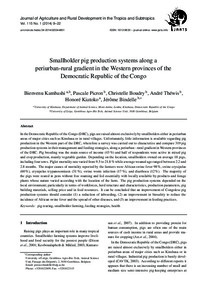Datum
2014Autor
Kambashi, BienvenuPicron, PascaleBoudry, ChristelleThéwis, AndréKiatoko, HonoréBindelle, JérômeSchlagwort
630 Landwirtschaft, VeterinärmedizinMetadata
Zur Langanzeige
Aufsatz

Smallholder pig production systems along a periurban-rural gradient in the Western provinces of the Democratic Republic of the Congo
Zusammenfassung
In the Democratic Republic of the Congo (DRC), pigs are raised almost exclusively by smallholders either in periurban areas of major cities such as Kinshasa or in rural villages. Unfortunately, little information is available regarding pig production in the Western part of the DRC, wherefore a survey was carried out to characterize and compare 319 pig production systems in their management and feeding strategies, along a periurban - rural gradient inWestern provinces of the DRC. Pig breeding was the main source of income (43%) and half of respondents were active in mixed pig and crop production, mainly vegetable garden. Depending on the location, smallholders owned on average 18 pigs, including four sows. Piglet mortality rate varied from 9.5 to 21.8% while average weaned age ranged between 2.2 and 2.8 months. The major causes of mortality reported by the farmers were African swine fever 98 %, swine erysipelas (60 %), erysipelas trypanosomiasis (31 %), swine worm infection (17 %), and diarrhoea (12 %). The majority of the pigs were reared in pens without free roaming and fed essentially with locally available by-products and forage plants whose nature varied according with the location of the farm. The pig production systems depended on the local environment; particularly in terms of workforces, herd structure and characteristics, production parameters, pig building materials, selling price and in feed resources. It can be concluded that an improvement of Congolese pig production systems should consider (1) a reduction of inbreeding, (2) an improvement in biosafety to reduce the incidence of African swine fever and the spread of other diseases, and (3) an improvement in feeding practices.
Zitierform
In: Journal of Agriculture and Rural Development in the Tropics and Subtropics. Kassel : Kassel University Press. - Vol. 115, No. 1 (2014), S. 9-22Sammlung(en)
Vol 115, No 1 (2014) (Journal of Agriculture and Rural Development in the Tropics and Subtropics (JARTS))Zitieren
@article{urn:nbn:de:hebis:34-2014020344851,
author={Kambashi, Bienvenu and Picron, Pascale and Boudry, Christelle and Théwis, André and Kiatoko, Honoré and Bindelle, Jérôme},
title={Smallholder pig production systems along a periurban-rural gradient in the Western provinces of the Democratic Republic of the Congo},
year={2014}
}
0500 Oax 0501 Text $btxt$2rdacontent 0502 Computermedien $bc$2rdacarrier 1100 2014$n2014 1500 1/eng 2050 ##0##urn:nbn:de:hebis:34-2014020344851 3000 Kambashi, Bienvenu 3010 Picron, Pascale 3010 Boudry, Christelle 3010 Théwis, André 3010 Kiatoko, Honoré 3010 Bindelle, Jérôme 4000 Smallholder pig production systems along a periurban-rural gradient in the Western provinces of the Democratic Republic of the Congo / Kambashi, Bienvenu 4030 4060 Online-Ressource 4085 ##0##=u http://nbn-resolving.de/urn:nbn:de:hebis:34-2014020344851=x R 4204 \$dAufsatz 4170 7136 ##0##urn:nbn:de:hebis:34-2014020344851
<resource xsi:schemaLocation="http://datacite.org/schema/kernel-2.2 http://schema.datacite.org/meta/kernel-2.2/metadata.xsd"> 2014-08-25T10:14:39Z 2014-08-25T10:14:39Z 2014 1612-9830 urn:nbn:de:hebis:34-2014020344851 http://hdl.handle.net/123456789/2014020344851 eng Kassel University Press Urheberrechtlich geschützt https://rightsstatements.org/page/InC/1.0/ pig rearing Smallholder farming feeding strategies health 630 Smallholder pig production systems along a periurban-rural gradient in the Western provinces of the Democratic Republic of the Congo Aufsatz In the Democratic Republic of the Congo (DRC), pigs are raised almost exclusively by smallholders either in periurban areas of major cities such as Kinshasa or in rural villages. Unfortunately, little information is available regarding pig production in the Western part of the DRC, wherefore a survey was carried out to characterize and compare 319 pig production systems in their management and feeding strategies, along a periurban - rural gradient inWestern provinces of the DRC. Pig breeding was the main source of income (43%) and half of respondents were active in mixed pig and crop production, mainly vegetable garden. Depending on the location, smallholders owned on average 18 pigs, including four sows. Piglet mortality rate varied from 9.5 to 21.8% while average weaned age ranged between 2.2 and 2.8 months. The major causes of mortality reported by the farmers were African swine fever 98 %, swine erysipelas (60 %), erysipelas trypanosomiasis (31 %), swine worm infection (17 %), and diarrhoea (12 %). The majority of the pigs were reared in pens without free roaming and fed essentially with locally available by-products and forage plants whose nature varied according with the location of the farm. The pig production systems depended on the local environment; particularly in terms of workforces, herd structure and characteristics, production parameters, pig building materials, selling price and in feed resources. It can be concluded that an improvement of Congolese pig production systems should consider (1) a reduction of inbreeding, (2) an improvement in biosafety to reduce the incidence of African swine fever and the spread of other diseases, and (3) an improvement in feeding practices. open access In: Journal of Agriculture and Rural Development in the Tropics and Subtropics. Kassel : Kassel University Press. - Vol. 115, No. 1 (2014), S. 9-22 Kambashi, Bienvenu Picron, Pascale Boudry, Christelle Théwis, André Kiatoko, Honoré Bindelle, Jérôme Gedruckte Ausg. im Verlag Kassel Univ. Press (www.upress.uni-kassel.de) erschienen. </resource>
Die folgenden Lizenzbestimmungen sind mit dieser Ressource verbunden:
Urheberrechtlich geschützt

